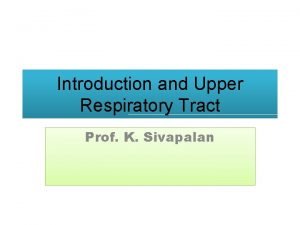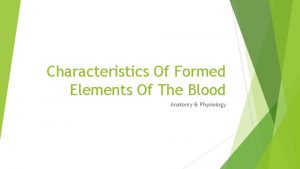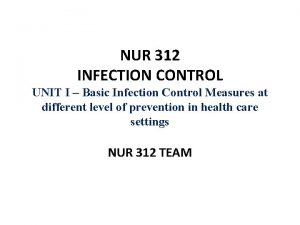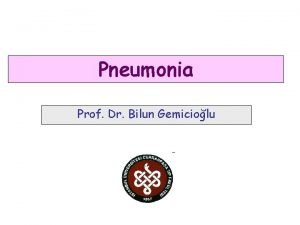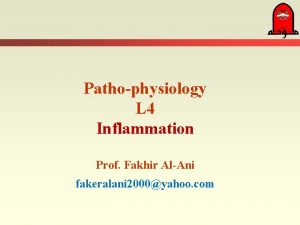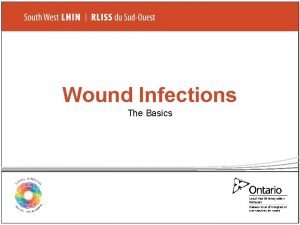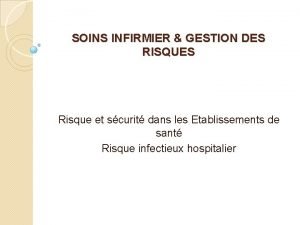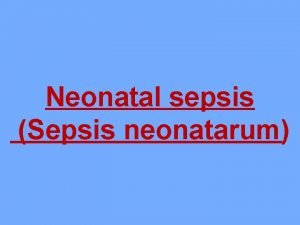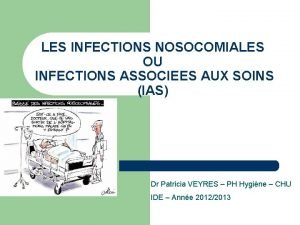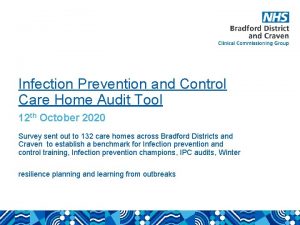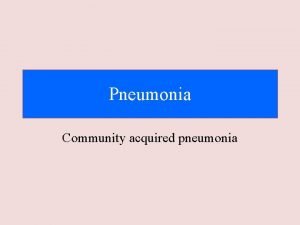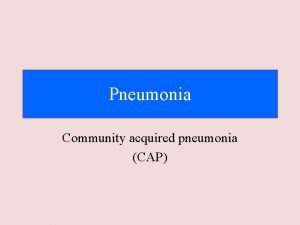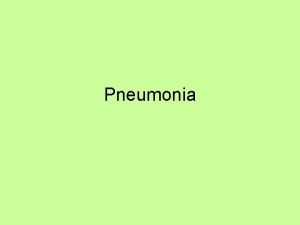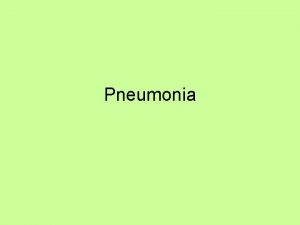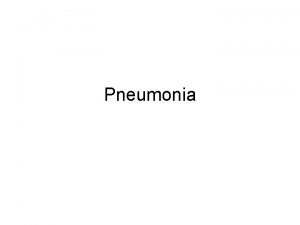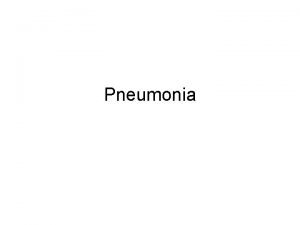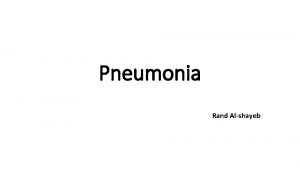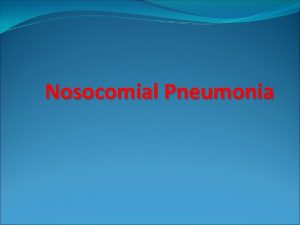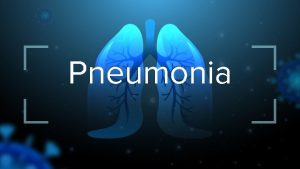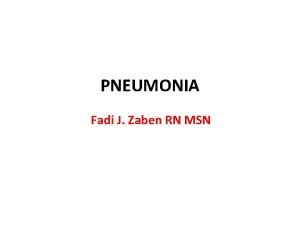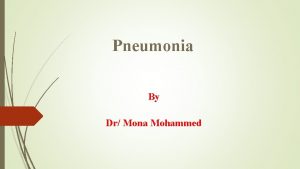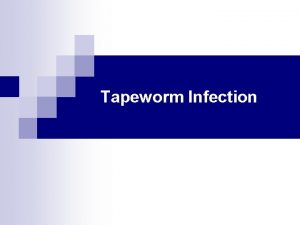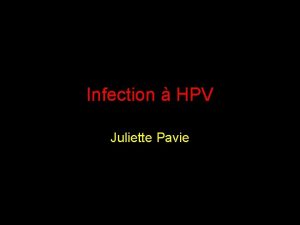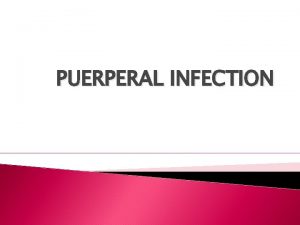pneumonia Definition Pneumonia is an acute infection of



























- Slides: 27

pneumonia

Definition Pneumonia is an acute infection of lung parenchyma characterized by (accumulation of secretions and inflammatory cells in alveoli).

Clinical classification �Community-acquired pneumonia (CAP): Onset in community or during 1 st 2 days of hospitalization. �Hospital-acquired Pneumonia(HAP/nosocomial): Occurring 48 hrs after hospitalization � Aspiration pneumonia �Pneumonia in immunocompromised patient

Anatomical classification �Lobar pneumonia if one or more lobe is involved �Broncho-pneumoniamore patchy alveolar consolidation associated with bronchiolar inflammation often affecting both lower lobes

causes Streptococcus pneumonia. � H. influenza � mycoplasma pneumonia. � Others like moraxella catarrhalis, legionella, , chlamydia, gram negative bacteria, coxiella, viral , staphylococcus aureus and MRSA. Ø

Factors that predispose to pneumonia �Cigarette smoking �Upper respiratory tract infections �Alcohol �Corticosteroid therapy �Old age �Recent influenza infection �Pre-existing lung disease �HIV �Indoor air pollution


�Exposure to contaminated air-conditioning cooling towers, recent travel �associated with a stay in a hotel--- Legionella pneumophila �Outbreak of pneumonia in shelters for homeless men, jails, military training camps--Streptococcus pneumoniae; Mycobacterium tuberculosis �Exposure to turkeys, chickens, ducks, or psittacine birds---C. psittaci

Clinical features Fever q Rigor q Cough with purulent sputum q Pleuritic chest pain q Dyspnea q +- confusion q

�Typical pneumonia: Respiratory symptoms are more than constitutional symptoms �Atypical pneumonia: Constitutional symptoms are more than respiratory symptoms

Atypical pneumonia Causative agent Mycoplasma pneumoniae Onset Gradual Symptoms Fever (low -grade)+ chills but no rigors Non-productive cough Headache – malaise Signs are usually minimal; Scattered crepitations and ronchi – sinus tenderness – No signs consolidation –

On examination Fever Tachycardia and tachypnea( Pulse oximetry) When consolidated, conduction of sound is enhanced the lung is typically dull to percussion and, as conduction of sound is enhanced, auscultation reveals bronchial breathing and crackles. ( in many patients, signs are more subtle with reduced air entry only, but crackles are usually present)

Atypical Pneumonia � Pt. has mainly constitutional symptoms and not respiratory symptoms. � Cause: � Mycoplasma (most common), legionella, chlamydia, coxiella, viral.

D/Diagnosis �Pulmonary edema �Pulmonary embolism. �Pulmonary TB �Pulmonary ca. �Pulmonary haemorrhage.

investigations �The aims of investigation are �Confirm the diagnosis �Exclude other conditions �Assess the severity �Identify the development of complications

Investigations CBC: leukocytosis Haemolytic anaemia: occasional complication of Mycoplasma CRP&ESR: Urea: lft Blood culture Sputum: Gram stain / C&S Chest x ray ABG Serology: Acute and convalescent titres for Mycoplasma, Chlamydia, Legionella and viral infections �Urine Pneumococcal and/or Legionella antigen �Pleural fluid Always aspirate and culture when present in more than trivial amounts, preferably with ultrasound guidance

Radiological classification �Lobar Pneumonia: �Homogeneous consolidation with air Broncho gram of one or more lung lobes. �Mainly caused by Streptococcus pneumonia.

Bronchopneumonia: - Usually bilaterally affecting lower lobes.

treatment �Adequate oxygenation �Appropriate fluid balance (case wise) �Antibiotics � Oxygen IV fluids. Analgesia. �Antibiotics (Empiric antibiotic therapy) Out pt. : Amoxicillin + macrolide ( azithromycin) 2. In hospital: {{3 rd generation Cephalosporin or Amoxiclvulenic acid}} + Macrolide (azithromycin) 1.

Use of ntibiotics �clinical context. �severity assessment. �local knowledge of antibiotic resistance patterns. �any available epidemiological information.

CURB-65 score �C -Confusion �U - Urea > 20 mg/dl �R -Respiratory rate >30min �B -BP <90 systole or <60 diastole � 65 -Age >65 { One Degree for each point } �. 0 -1 outpatient treatment with oral antibiotics �. 2 Admission to the hospital �. ≥ 3 severe pneumonia treated at ICU

Complications of Pneumonia 1. 2. 3. 4. 5. 6. 7. Respiratory failure type I Para-pneumonic effusion. Empyema Lung abscess ARDS. Renal failure. Septicemia.

Interstitial pneumonia

Delayed resolution �? incorrect diagnosis. � Incorrect microbiological diagnosis. Fungal, tubercular recurrent aspiration � Improper antibiotic or insufficient dose � pneumonia may be secondary to a proximal bronchial obstruction ca OR FBody �complication has occurred (Empyema or atelectasis) �Immunocompromised patient

A 21 -year-old woman with no known medical history or prior hospitalization was presented to the emergency department with complaints of shortness of breath, cough, and fevers for 3 days. On examination : blood pressure of 120/80 mm. Hg, heart rate o 110/min, respiratory rate of 18/min, temperature 38. 1ºC, and oxygen saturation 95% on room air. And She had few crackles in the LLL. Laboratory evaluation showed white blood cell count 14, 000/m/μL with a left shift , hemoglobin 14 g/d. L, platelets 300, 000/μL, sodium 145 m. Eq/L, potassium 4 m. Eq/L, chloride 101 m. Eq/L, bicarbonate 28 m. Eq/L, blood urea nitrogen 16 mg/d. L, creatinine 0. 6 mg/d. L, glucose 100 mg/d. L. and chest radiography revealed LLLC.

What antibiotics should she be treated with? A. Ceftriaxone 1 g intramuscularly once a day B. Azithromycin and ceftriaxone for at least 3 days and then continue to de-escalate if patient improves C. Vancomycin and cefepime for at least 3 days and then continue to de-escalate if patient improves D. Hold antibiotics until further tests such as Legionella urine antigen and strep urine antigen. E. Azithromycin 500 mg PO daily for 3 days.

�Thank u
 Acute specific surgical infection
Acute specific surgical infection Broncheols
Broncheols Active phagocytes that increase rapidly acute infection
Active phagocytes that increase rapidly acute infection Infection control meaning
Infection control meaning Bilun gemicioğlu
Bilun gemicioğlu Verminous pneumonia definition
Verminous pneumonia definition Subcecal appendix
Subcecal appendix Dr el sabbagh
Dr el sabbagh Acute responses to training definition
Acute responses to training definition Parodontitis acuta
Parodontitis acuta Bell clapper deformity pictures
Bell clapper deformity pictures L
L Congruent sides
Congruent sides Cellular events of inflammation
Cellular events of inflammation Cellular events of acute inflammation
Cellular events of acute inflammation Wound infection continuum
Wound infection continuum Kidney infection
Kidney infection Torches infection
Torches infection Safirh ets
Safirh ets Infection nosocomiale
Infection nosocomiale Dental radiography ppt
Dental radiography ppt Neonatarum
Neonatarum Standard precautions cosmetology
Standard precautions cosmetology Primo infection tuberculeuse
Primo infection tuberculeuse Flore transitoire
Flore transitoire Circuit du linge propre
Circuit du linge propre Infection controlcare home
Infection controlcare home Types of infection
Types of infection

